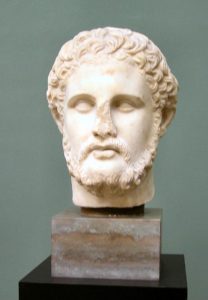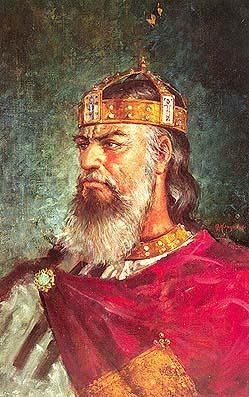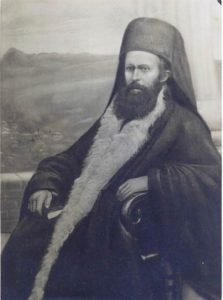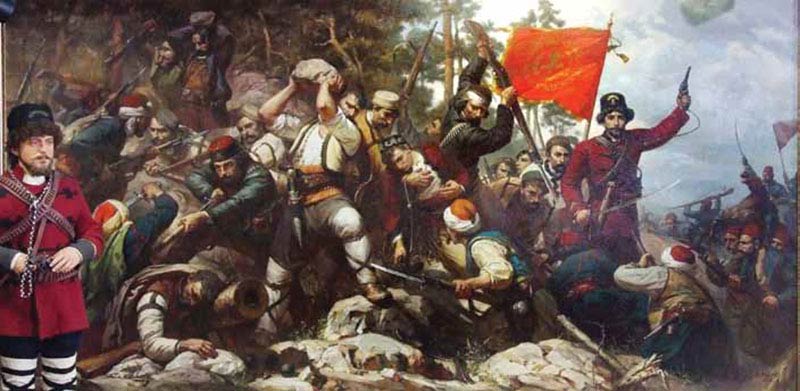Table of Contents
Within a relatively small area, as can rarely be seen elsewhere in the world, the large number of events and many changes have taken place throughout history which have also carried significance for people in other regions. Macedonia has been a place where enduring achievements have been realized over the centuries and where religions and civilizations have intertwined. Among those achievements, the most sacred for the Macedonian Slavs is the alphabet created by the Salonica brothers Cyril and Methodius.
As a historical and geographical region, Macedonia occupies the part of the Balkan Peninsula bounded to the north by the Shar, Skopska Crna Gora, Kozjak, Osogovo and Rila mountains; it extends to the east up to the western part of the Rhodopes and the River Mesta, to the south down to the Aegean Sea and the river Bistrica, and to the west it is bounded by Mounts Korab, Jablanica, Mokra and Pindus. Its total territory covers 67,741 square kilometers, 25,441 square kilometers of which constitute the territory of the Republic of Macedonia, while Aegean and Pirin Macedonia are located within the boundaries of Greece and Bulgaria respectively.
Even in its most distant past, Macedonia was a place where different civilizations and religions came into contact. Its geographic and strategic position, taking in a large belt of the Aegean Sea and occupying the crossroads of important international routes, led to Macedonia’s early exposure to the influence of the developed Mediterranean basin. At the same time, as the area was absorbing various influences, it was also spreading its own influence over the wider region of the Mediterranean. it is noteworthy, for example, that Christianity emerged here very early.
The Classical Period
The earliest history of Macedonia is known on account of the ancient Macedonian state in the time of Philip II (359-336 BC) and the “world state” of his son Alexander the Great (Alexander of Macedon, 336-323 BC). Following the collapse of Alexander’s empire, Macedonia continued to exist as part of the Roman Empire and later as part of the Byzantine Empire. During the long period, owing to its geographical position and the alterations in its administrative borders, Macedonia underwent frequent changes.
During the course of these continual changes the ethnic composition of the region’s population also changed. Thracians and Illyrians are known to have lived there early on, after which various barbarian tribes came in later classical period. The mass settlement of the Slavs in the 6th century AD led to the swift assimilation of the ancient Macedonian population by the newly-arrived tribes and to huge changes in the region’s ethnic composition.
The territory of Macedonia has seen various civilizations and cultures, starting from prehistory, the Paleolithic and the Neolithic, through the Classical Period, Ancient Macedonia, Rome, the Byzantine Empire, the emergence of the “sclavinae” and the Christianization of Macedonian tribes, and later the penetration of Islam. Its heritage is part of the cultural heritage of the world, and not only of the modern nations and states. It is an irrefutable fact that the state of Philip II and Alexander the Great stretched to the north to a point midway between the modern towns of Skopje and Titov Veles, which is sufficient confirmation that the Republic of Macedonia has as exclusive a right to the cultural heritage of the ancient Macedonians as the Republic of Greece has. Since the downfall of Alexander’s Empire, the Republic of Macedonia is the first state (established in 1944) to bear the name of Macedonia. This certainly cannot imply a right to monopolization of its name. And finally, on maps, in heraldry and in historical documents, Macedonia was denoted as a whole in a territorial and ethnic sense until its partition in 1913.
All civilizations and cultures in the territory of Macedonia which have come into contact with each other over the millennia, and produced and created here from one epoch to another, have crystallized a cultural constant, amalgamating heterogeneous cultural components into a new quality: the Macedonian Slavic civilization and culture. There is a predominant feeling in the Republic of Macedonia that the history of Macedonian culture should be interpreted in accordance with the new European understanding of the cultural history of the Balkans as a unique civilizational agglomeration with several individual and autochthonous cultural systems.
Yet in the course of history their civilizational matrix has many times been identical, which necessitates the discovery of the modalities of their intercultural patterns and interdependence. Therefore it is impossible to evaluate the history of what has been historically and geographically designated Macedonia and valorize its heritage as long as the typical Balkan panideologization of culture and typical Balkan cultural nihilism prevail.
Samuil’s State
The long waves of penetration of the Slavs towards the end of the 7th century AD resulted in an entirely different situation – Macedonia acquired new inhabitants and became a Slav territory. The “sclavinia” was their first form of social organization and structure. Then they fell under the Byzantine and Bulgarian Empires. Following the fall of the Bulgarian Empire and the decline of the Byzantine Empire, Samuil, a skilled military leader and statesman, established the first Macedonian state (976-1018).
Samuil’s Empire comprised the whole of Macedonia, Thessaly, Epirus, Albania and the former coastal sclavinae of Duklja, Travunja, Zahumlje and the Neretva region, and also Serbia (i.e. Rashka) and a considerable part of Bulgaria. In this large empire, the most numerous subjects were the Macedonian Slavs, the Slavs in Greece and Peloponnesus, and only then Bulgarians, followed by Serbs, Croats and finally “Romaioi” (Byzantines), Albanians and Vlachs.
Heading this conglomeration of people was Tsar Samuil, who was crowned by the Roman Pope, because Samuil was in constant conflict with the Byzantine Empire, and the crown of Bulgarian rulers was in Constantinople. This crowning gave an international character and recognition to Samuil’s Empire. The attribute “Bulgarian” is explained by the practice of the Roman Pope to give a title to the crown which was identified with the territory of an already recognized empire, and Samuil’s Empire extended over the territory of the Bulgarian Empire which had collapsed.
Samuil had a crown, secretaries and bureaucracy; there was an emperor’s office issuing documents. The official language in Samuil’s Empire was Slavonic, although as a diplomatic language of the court Greek was also used. The Archbishopric of Ohrid was established at the time of Samuil, and Ohrid became the religious center and the capital of the empire.
Following the final subjugation of Samuil’s state in 1018, the Byzantine Empire dealt fiercely with the Macedonian population, particularly those living in towns: they were banished and aliens were brought in their place. The Byzantine Empire also placed the Archbishopric of Ohrid under jurisdiction of the Patriarchate of Constantinople, and the Greek hierarchs started suppressing Slavonic written documents, Slav hagiographies, etc. It was considered that with the eradiction of the Archbishopric of Ohrid the tradition cherished by the Macedonian people would also be eradicated.
Yet Slavonic literacy could not be eradicated. the extraordinary work of the educators Cyril and Methodius had a firm basis. As well as creating the first Slavonic alphabet (Glagolitic), translating the basic religious service books from Greek into the language spoken by the Macedonian Slavs in the surroundings of Salonika and establishing Old Slavonic literature, Cyril and Methodius also expanded their activity among other Slavs.
Clement and Naum continued the mission of the Salonika brothers. In Ohrid, during his activity of 20 years, Clement instructed about 3,500 teachers and priests in Slavonic alphabet and introduced the Slavonic language in religious service. he was the first original Slav and Macedonian writer. the Ohrid Literary School, being the first Slav university, has left deep traces and has been the basis for Macedonian cultural identity.
Turkish Rule in Macedonia
Following the fall of Samuil’s Empire, Macedonia was transformed into an ordinary Byzantine province. the period of developed feudalism was characterized by constant struggle against Byzantine authorities and the new rise of Bogomil movement in Macedonia. At the end of 11th century, the Byzantine Balkan territories were attacked by the Normans. Then the Crusaders penetrated Macedonia, and for a brief period it came under the rule of mediaeval Serbian state.
At the end of the 14th century, after a famous battle near river Marica, Macedonia came under the Turkish rule. The history of Macedonia in the period between 15th and 16th centuries was characterized by the establishment of the Timar-Spahi system and other forms of Ottoman feudal exploitation. Agriculture at this period was the basic source of livelihood.
Alongside this economic exploitation, the Macedonian people was religiously and ethnically discriminated against, which may be seen from the concept of “raya”, which was a synonym for having no rights. For a long period Macedonia was subject to a dual domination: economically and politically to the Sultan’s rule, and religiously to the rule of the Constantinople Patriarchate, at the head of which were Greeks.
The struggle against feudal exploitation and Turkish rule in Macedonia took the form of repeated rebellions and insurrections, which later developed into organized “ajduk” strife (ajduks were outlaws opposed to Turkish rule). In 1564-1565 the Mariovo-Prilep rebellion took place, and in the 17th century ajduk companies attacked Osmanli feudal property. In 1689, part of Macedonian population organized an uprising known according to the name of its leader as the Karposh Uprising.
The economical and political situation in Macedonia further deteriorated. The weakening of the power of the central Ottoman authorities led to rise of the power of the big landowners and cruel feudal anarchy. The Empire’s decline at the end of the 18th century and beginning of the 19th century was accompanied by the first emergence of capitalism in Macedonia and the intensifying of the national liberation activities. Macedonians took an active part in the insurrections of the neighboring people. The attempts of the Ottoman Empire at reforms in the social, economic and political system in Macedonia, made under the pressure of the contemporary European Great Powers, did not lead to any improvement in the difficult situation.
Following its defeat in the 1877/78 war with Russia and the Treaty of San Stefano, the Ottoman Empire’s Balkan territories were considerably reduced. Serbia, Montenegro and Romania were proclaimed independent, and Macedonia was annexed to the newly-established Bulgarian state. The revision enacted by the Congress of Berlin held in July 1878, according to which Macedonia remained under the authority of the Ottoman Empire, was just as great injustice towards the Macedonian people as the clause referring to Macedonia in the Treaty of San Stefano. By ignoring the real interests and struggle of the Macedonian people for liberation and a state of their own. European diplomacy encouraged the nationalist and expansionist myths of the neighboring Balkan states, and turned the Macedonian Question into an important European political question.
The Struggle for Cultural Revival
The struggle of the Macedonian people for the preservation of Slavonic literacy and cultural identity, although conducted in extremely difficult circumstances, never ceased. In the 17th and 18th centuries, there was a period in Macedonia of translating collections with different contents called “damaskins” in which elements of the Macedonian colloquial speech were included. At that time several important works of Slavonic literacy were created in Macedonia. The struggle for autonomous spiritual and cultural life and schools in the Macedonian language, although hampered by the Greek clergy through the Constantinople Patriarchate, proceeded uninterruptedly. In the 1830s the foundations were laid of the first Macedonian church-educational communities.
Macedonian intelligentsia fought the war for Macedonian culture and education on two fronts simultaneously: against the Greek clergy which tried through its Patriarchate schools to impose Greek language, and against attempts at the imposition of the Bulgarian language in their schools. the resistance and endeavors for the establishment of a Macedonian literary standard expressed the aspirations for an independent national development. The first to introduce the use of the Macedonian language in textbooks was Partenija Zografski. among the numerous writers of textbooks in Macedonian, of particular significance were Dimitar Makedonski, Kuzman Shapkarev, Venijamin Machukovski and Gjorgji Pulevski.
An event of extreme importance for Macedonian culture was the publication in 1861 of a collection of Macedonian folk songs by Konstantin Miladinov. the emergence of modern Macedonian poetry is also associated with his name. Macedonian intellectuals from the second half of 19th century organized themselves into numerous societies and circles whose purpose was to study the historical past, culture, language and customs of the Macedonian people, thus combating the propaganda of the neighboring states. In the 1880s, Pulevski affirmed the autonomous status of the Macedonian language with his two dictionaries. In 1903, Krste Petkov Misirkov raised the Macedonian language to the level of a standard literary language.
The Kresna Constitution and the Krushevo Republic
The struggle of the Macedonian people for national revival, liberation and the establishment of a state of their own was completely and definitely articulated in the second half of the 19th century. As a result of dissatisfaction with the decisions of the Congress of Berlin, an insurrection began in October 1878 known as Kresna uprising. According to the Rules of the Macedonian Uprising Committee, known as the Constitution of this Uprising, its main purpose was the liberation of Macedonia and the establishment of a Macedonian state. In a special chapter the bases of the external policy of the insurrectionary people were set forth, with particular regard to the neighboring states and people.
As a result of growing national and political emancipation and the struggle against foreign propaganda, the Internal Macedonian Revolutionary Organization (VMRO) was established in Salonica in 1893. This organization was a decisive response to foreign propaganda and attempts at political penetration into the fabric of the Macedonian national liberation struggle.
The Macedonian national movement stirred up the European political scene in 1903 with the glorious Ilinden Uprising and the establishment of the Krushevo Republic. The Krushevo Manifesto, as a declaration of the first republic in the Balkans, with its political ideas and the envisaged establishment of institutions of government, corresponded with the highest democratic values of contemporary Europe.
The Division of Macedonia
The collapse of the Ottoman Empire and the two Balkan Wars (1912-1913) changed the situation in the Balkans, but did not mean freedom for Macedonia and the Macedonians. With 1913 Treaty of Bucharest, Macedonia was divided between Greece, Serbia and Bulgaria.
The Balkan Wars and the First World War marked period of unseen terror, atrocities and brutal assimilation. The Macedonians were forcibly mobilized in foreign armies and were killed “en masse” on the fronts.
Following the war, the 1919 Treaty of Versailles only endorsed the previous division. This treaty had disastrous consequences for Macedonia. It shattered the geographic, ethnic and economic unity of the Macedonian people.
As a result of the policy of interest spheres by Great Powers, the Macedonian Question remained open. Vardar Macedonia (the territory of today’s Republic of Macedonia) became part of the newly-established Kingdom of Serbs, Croats and Slovenes – later known as the Kingdom of Yugoslavia – which existed until 1941. The largest part of Macedonia, geographically known as Aegean Macedonia, covering the area of 34,356 square kilometers, was incorporated into Greece. Prior to the Balkan Wars, the Greeks constituted not more than 10% of the population living in the Aegean part of Macedonia. Macedonian was the prevailing language, and Greek was the language of a minority. The ethnic composition started changing in favor of the Greek element only after 1928 when Aegean Macedonia was systematically colonized by a population of various ethnic affiliations (Greeks, Turkish-speaking Karamanlis, Armenians, etc.). The territory of Pirin Macedonia, covering an are of 6,798 square kilometers and having a compact Macedonian population, was assigned to Bulgaria.
The position of the Macedonian people in the three dismembered parts in the period 1918-1941 was extremely difficult. The Yugoslav, Greek and Bulgarian governments created special propaganda machinery for national oppression and assimilation. They used various forms of economic pressure, political, military and police terror, unprecedented in modern Europe history. brutal denationalization, replacement of Macedonian names and toponymy was carried out and the Macedonian language was suppressed. Yet, in spite of the colonization with a non-Macedonian population of about 750,000, between two world wars the Macedonian still formed the majority of the population in all three parts of Macedonia.
Sovereign and Independent Macedonia
In the Second World War, with the struggle it organized against the fascist occupiers starting on October 11, 1941, the Macedonian people secured its place among the freedom-loving and democratic people of Europe and the world. the Macedonian people established its own army and in 1944 liberated most of its territory with its own forces.
The First Session of ASNOM (The Anti-Fascist Assembly of the National Liberation of Macedonia) was held on August 2, 1944. It finally crowned the process of historical establishment of the Macedonian state and was the basis for its sovereignty and integrity. The state’s status as a subject, its political and legal sovereignty, and its territorial and national integrity, as set out in the resolutions of ASNOM, served as the bases for the Macedonian people’s coexistence with neighboring people and for the foundation of a new European order. As a legislative and executive body, ASNOM also had all the prerogatives of a state-constitutional institution.
The Republic of Macedonia is a state constituted by the will of its citizens within the framework of the new political order following the Second World War. National, political, territorial and economic integrity, and the state-constitutional and international status of Macedonia are part of that political order. As a state within the framework of Yugoslavia, in its international legal contacts and in its international economic, political and cultural relations and cooperation, Macedonia exercised all the basic functions of a separate entity.
On September 8, 1991, Macedonia held a referendum on its sovereignty and independence. On November 17, 1991, a new Constitution was adopted, which proclaimed the Republic of Macedonia a sovereign and independent state.
On April 8, 1993, the Republic of Macedonia became a member of the united Nations Organization.

Virtual Macedonia
Republic of Macedonia Home Page
Here at Virtual Macedonia, we love everything about our country, Republic of Macedonia. We focus on topics relating to travel to Macedonia, Macedonian history, Macedonian Language, Macedonian Culture. Our goal is to help people learn more about the "Jewel of the Balkans- Macedonia" - See more at our About Us page.
Leave a comment || Signup for email || Facebook |
History || Culture || Travel || Politics




















